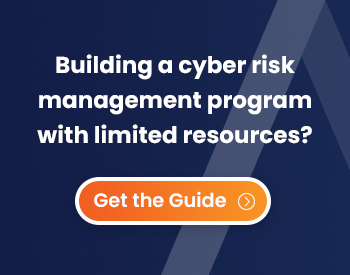Aligning your cyber risk management program with your company’s bottom line
The key to gaining buy-in for your cyber risk roadmap under tightening budgets and staffing challenges.
This statement should come as no surprise: there’s been an alarming rise in the number and sophistication of cyber attacks this year. In fact, IT Security Company NCC Group’s Monthly Threat Pulse of March 2023 recently reported a 91% increase in ransomware attacks in March 2023 compared to February 2023 and a 62% increase year over year when compared to data from March 2022. Just take the cyber attack on MGM Resorts earlier this month – you don’t have to look far to see that ransomware is still at large.
Meanwhile, you have the SEC’s 2022 proposal on new regulations for cyber security risk management, governance, and incident disclosure, which has public companies rethinking how they keep their Board and Stakeholders informed.
So, whether by need or demand, companies of all sizes and complexities are re-evaluating and reinforcing their cyber risk management programs. But the question is: how do you build mature cyber security programs within your business while facing budget constraints and workforce reductions? How can you get buy-in from your Board if there is a lack of critical know-how regarding the evolving threatscape and its potential impact?
Facing the risk-to-resource conundrum head on
Attacks are up, costs are up, the number of bad actors is rising— the risk industry is at an inflection point. When companies can plan and respond with agility (and receive the investment needed to do so), serious success follows on their heels. But securing investment in a financially constricted market is difficult.
There are 3 main hurdles standing between you and a more robust cyber risk management program that aligns with your company’s economic and operational goals:
Hurdle #1) A Lack of Technical Know-how
Workforce reductions and turnover have created knowledge gaps — particularly within smaller organizations and at a senior level within larger businesses.
The Solution: Lean on the people in your organization (including those who fall outside of your department) who have the necessary skills. Embed them in your program from the very beginning, saving on the costs of training new hires and minimizing the need to ask for more open roles.
Hurdle # 2) A Limited GRC Budget
Our business activities are dictated by the bottom line — especially in today’s environment, where the global economy continues to contract, layoffs and budget cuts are prevalent, and supply chain volatility is at an all-time high.
Knowing that investment in cyber security initiatives is usually viewed as costs rather than improvements —and that resources are tight across departments — it’s never been more important for risk professionals to connect their goals with the bottom line of their company.
The Solution: Quantify the risk of breach! How many records are held in that particular application? What kind of data? When you can put a dollar sign or time stamp in front of the impact scope, more people are likely to listen. But you have to know what your organization is interested in, and adapt your metrics to fit that model.
Hurdle #3) Keeping up with an evolving riskscape (and vendor network)
Less than one in ten organizations actively monitor the risks within their supply chains, which means that outsourcing services to third-party vendors amplifies risk. As companies rely more heavily on third-party assistance, the threatscape continues to grow.
The solution: Continuous risk monitoring and quantification allow you to keep a consistent pulse on any updates that could impact your business continuity.
Of course, these solutions are simplified and streamlined here for the sake of time. For a more detailed look at how to Build a Cyber Risk Management Program with Limited Resources, explore our White Paper.




